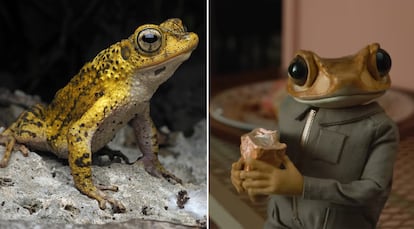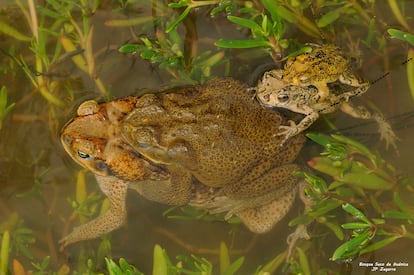The Puerto Rican crested toad: The shy star of Bad Bunny’s new album and a symbol of resistance
The habitat of this endemic species is threatened by climate change and by some of the other problems denounced in the album ‘DeBÍ TiRAR MáS FOToS,’ such as gentrification and touristification

After having the spotlight on him, the Puerto Rican crested toad’s private life is now in the public eye.
According to specialists, this animal usually spends most of its time in hiding. It only comes out when it rains, in order to reproduce. This usually takes place in the ponds of Puerto Rico’s dry forest. However, in recent weeks, millions of people have seen the toad in the privacy of its home: dancing while cleaning and listening to music, doing yoga, practicing salsa, gardening, or eating quesito.
Known in Spanish as sapo concho, the amphibian is endemic to the Caribbean island. And while the creature is in danger of extinction, thanks to the short film that accompanies the new album by Bad Bunny, DeBÍ TiRAR MáS FOToS (“I should have taken more photos”), it has become a symbol of resistance against gentrification, touristification and climate change.
The first description of the Puerto Rican crested toad (Peltophryne lemur) dates back to 1868, when it was documented by the American paleontologist Edward Drinker Cope. Before that, it was also found in Virgin Gorda — the third-largest island of the British Virgin Islands, more than 120 miles away from Puerto Rico — where it was believed to be extinct for a period of 43 years, between 1931 and 1974. This is according to Rafael Joglar, a professor and researcher in the Department of Biology at the University of Puerto Rico, who spoke to EL PAÍS via video call.
This species, Joglar explains, was rediscovered in the early 1980s on the island. And from that moment on, its recovery and conservation process began. Joglar describes the toad as small — it can measure between two and five inches — and warty. It has large crests above the eyes and a pointed, upward-curving snout. Their skin tones can range from brown to greenish-yellow, as depicted by Bad Bunny’s character in DeBÍ TiRAR MáS FOToS.
The species that Concho, the singer’s toady friend, belongs to is mainly found in the karst region of Puerto Rico, composed of caves, underground streams and sinkholes. The limestone area covers approximately 27.5% of the island’s surface. According to Sondra Vega, a biologist and professor at the University of Puerto Rico who spoke to EL PAÍS via video call, this region is divided into the northern, southern and scattered limestone areas.
The largest natural population of Puerto Rican crested toads is found in the Guánica Forest, in the southwest of the island. The biosphere reserve is both an arid and semi-arid ecosystem. It’s not known exactly how many individuals of the species exist. However, Vega estimates that there are between 500 and 3,000 of these toads in the wild. “We’re talking about a species that spends most of its life in cracks, cavities or holes that form within the limestone rock, which is part of this type of ecosystem,” the biologist explains.
Despite its recent prominence in the public and cultural sphere, Joglar believes that almost no one in Puerto Rico has actually seen a sapo concho. This is because it’s a rare species that only comes out of its shelter to reproduce when there are dramatic atmospheric events — such as hurricanes or strong storms — that produce rain and puddles. In the depressions in the ground that fill up with rainwater, the amphibian is able to lay its eggs. After a certain period of time, the larvae become tadpoles, developing in the water.
The fight for its habitat
In Puerto Rico, the crested toad has had to fight for its habitat just like the island’s locals, who deal with phenomena such as gentrification and tourism that displace them from their homes. But rather than battling against Americans or Europeans, the toads have to contend with the cane toad (Rhinella marina), an invasive species on the island that was imported in the early 1920s to control the white worm that was attacking the sugar cane crop.

“At the time, it was thought to be a good idea. The common toad ate everything except the white cane worm. But now we have a very big problem with that species, because it’s in direct competition with our own toad, since they use the same breeding sites,” Joglar explains.
The sapo concho can lay between 6,000 and 7,000 eggs, while the cane toad can lay up to 36,000. “These ponds where both species are present are going to be basically dominated by the invasive species. It points to a story with a sad ending, in which more and more of our native species is almost completely displaced,” the researcher adds.
As if being displaced by a species at least three times larger wasn’t enough, the Puerto Rican crested toad must also face the effects of climate change. This amphibian can go several years without reproducing, as it depends on atmospheric and climatic conditions. With the increase in temperatures in Puerto Rico, Joglar explains that amphibians are affected “very seriously.” They don’t have protection on their skin: neither scales like fish or reptiles, nor feathers and hair like birds and mammals. Additionally, they’re ectothermic animals, which implies that they cannot physiologically regulate their temperature.
“Everything that’s in their environment — whether in the water, in the air, or on land — penetrates them directly. They’re very sensitive to the issue of contamination. The coquíes (another amphibian on the island), for example, go up the mountains looking for cooler temperatures. The sapo concho, since it’s from the coast, cannot do the same,” the herpetologist continues.
Another factor that has been documented by the Coquí Project, a non-profit organization run by the biologist to preserve and research amphibians and reptiles, has been the “very marked” changes in precipitation patterns, with very dry periods that have been increasing in recent years in Puerto Rico.
“The third problem — and this is very particular to this species — is that, since it lives in ponds near the coast in southern Puerto Rico, the storm surges, due to erosion, have also been reducing the size of the coast. The ponds that the crested toad once used to reproduce are now being affected by salt water. [This] damages its habitat for its development and procreation,” Joglar laments.
But it’s not only global warming that’s displacing this species, which has been shown to live between four and six years in captivity. Vega also emphasizes the threat of urban sprawl, which entails the destruction or modification of the toad’s habitat, especially within coastal forests. Within Puerto Rico’s vision of economic development, based on the intrusive construction of tourist centers, it’s a challenge to make people aware about how such policies affect the island’s natural heritage.
Likewise, Vega thinks that the sapo concho is a victim of “identity theft.” Biologists who work with this species — which belongs to the Bufonidae family, the largest family of amphibians, consisting of 80 genera and 750 species — have made great efforts to clarify the difference between the Puerto Rican crested toad and the invasive toad from Suriname, or between the former and the coquí, another cultural emblem of Puerto Rico. This tree frog is a different species, one that reproduces all year round and doesn’t need to go into the water to lay eggs.
si, el coquí es emblemático de Puerto Rico y está en peligro de extinción, pero el protagonista de mi album no es un coquí, ES EL SAPO CONCHO; una especie también nativa de Puerto Rico y en peligro de extinción.
— Benito Antonio (@sanbenito) January 17, 2025
¡¡¡CONCHO!!! https://t.co/VjNRelrd4C
The figure of the coquí is “extremely important,” Vega emphasizes. There’s even a saying popular in Puerto Rico that states: “Soy de aquí, como el coquí.” (I’m from here, like the coquí) Its symbolism dates back to the pre-Columbian era, as it can be found in pictographs and in numerous archeological findings.
“The fact that Bad Bunny has decided to incorporate the sapo concho has given us the opportunity not only to educate [the public] about what it is, but also about what threatens it. And to feel committed and proud, because it’s part of our natural and cultural heritage,” Vega elaborates.
Joglar adds that he’s “amazed” and at the same time “grateful” that Bad Bunny has made it possible for Puerto Ricans to be able, “openly and publicly for the first time,” to discuss the topic of endangered species, specifically about the sapo concho. “It’s important that we know how to use this opportunity to debate and develop serious and massive education programs to change government policy on the use of fossil fuels and the threat of global warming.”
Within the conservation efforts, according to Vega, this species has been reproducing in captivity for decades, being released and reintroduced into its ecosystem. But monitoring the toad has been difficult due to its living conditions. Hence, there’s still a lot of work to be done, as well as many pending questions.
Despite all the adverse circumstances that affect it as a species, the Puerto Rican crested toad remains a symbol. It’s a popular character in the struggle against the displacement of local peoples, and in favor of the preservation of traditions. As is noted in Bad Bunny’s short film: “We’re still here.”
Sign up for our weekly newsletter to get more English-language news coverage from EL PAÍS USA Edition
Tu suscripción se está usando en otro dispositivo
¿Quieres añadir otro usuario a tu suscripción?
Si continúas leyendo en este dispositivo, no se podrá leer en el otro.
FlechaTu suscripción se está usando en otro dispositivo y solo puedes acceder a EL PAÍS desde un dispositivo a la vez.
Si quieres compartir tu cuenta, cambia tu suscripción a la modalidad Premium, así podrás añadir otro usuario. Cada uno accederá con su propia cuenta de email, lo que os permitirá personalizar vuestra experiencia en EL PAÍS.
¿Tienes una suscripción de empresa? Accede aquí para contratar más cuentas.
En el caso de no saber quién está usando tu cuenta, te recomendamos cambiar tu contraseña aquí.
Si decides continuar compartiendo tu cuenta, este mensaje se mostrará en tu dispositivo y en el de la otra persona que está usando tu cuenta de forma indefinida, afectando a tu experiencia de lectura. Puedes consultar aquí los términos y condiciones de la suscripción digital.
More information
Archived In
Últimas noticias
The story of the Málaga virus: The code that haunted Google’s cybersecurity center director for 30 years
The impact of Ecuador’s mega-prison: A polluted river, cleared forests and military checkpoints
Corinne Low: ‘I’m more concerned about the female happiness gap than the gender wage gap’
Trump traveled on Epstein’s plane ‘many more times’ than previously thought, according to new documents
Most viewed
- The low-cost creative revolution: How technology is making art accessible to everyone
- Christian Louboutin: ‘Young people don’t want to be like their parents. And if their parents wear sneakers, they’re going to look for something else’
- All the effects of gentrification in one corner of Mexico’s Colonia Roma
- Liset Menéndez de la Prida, neuroscientist: ‘It’s not normal to constantly seek pleasure; it’s important to be bored, to be calm’
- Christmas loses its festive spirit: ICE fears cast shadow over religious celebrations











































